Lonzino is one of the easiest dry-cured meats to make at home, or so they say, but it took me years to get excellent results. The problem for me was the drying process - I could never get a perfect drying from edge to edge. That resulted in off-flavors, unappetizing color, and poor texture. Too many spices was another problem. When I was just getting into meat curing, I was convinced that the secret to success was in some magic seasoning mix. A lot of people around me kept experimenting with seasonings to come up with winning flavor profiles. The truth is, in most cases salt and a touch of basic aromatic spices is all you need. Less is more when it comes to seasoning meat for curing.
Another problem for me was the curing time. Like many others, I wanted my lonzino to be ready asap. It can be. Pork loin without much/any fat on it can lose 35% of its green weight within 30-40 days. Is that good? Is 35% weight loss sufficient? In Italy, butchers seem to focus more on maturation time rather than weight loss. A butcher-friend from Italy once told me that he targets 4-6 months of maturation time for his lonzino. Why? The flavor. Like good wine or whisky, cured meat needs time to develop complex flavors, silky-smooth texture, and refined aromatics.
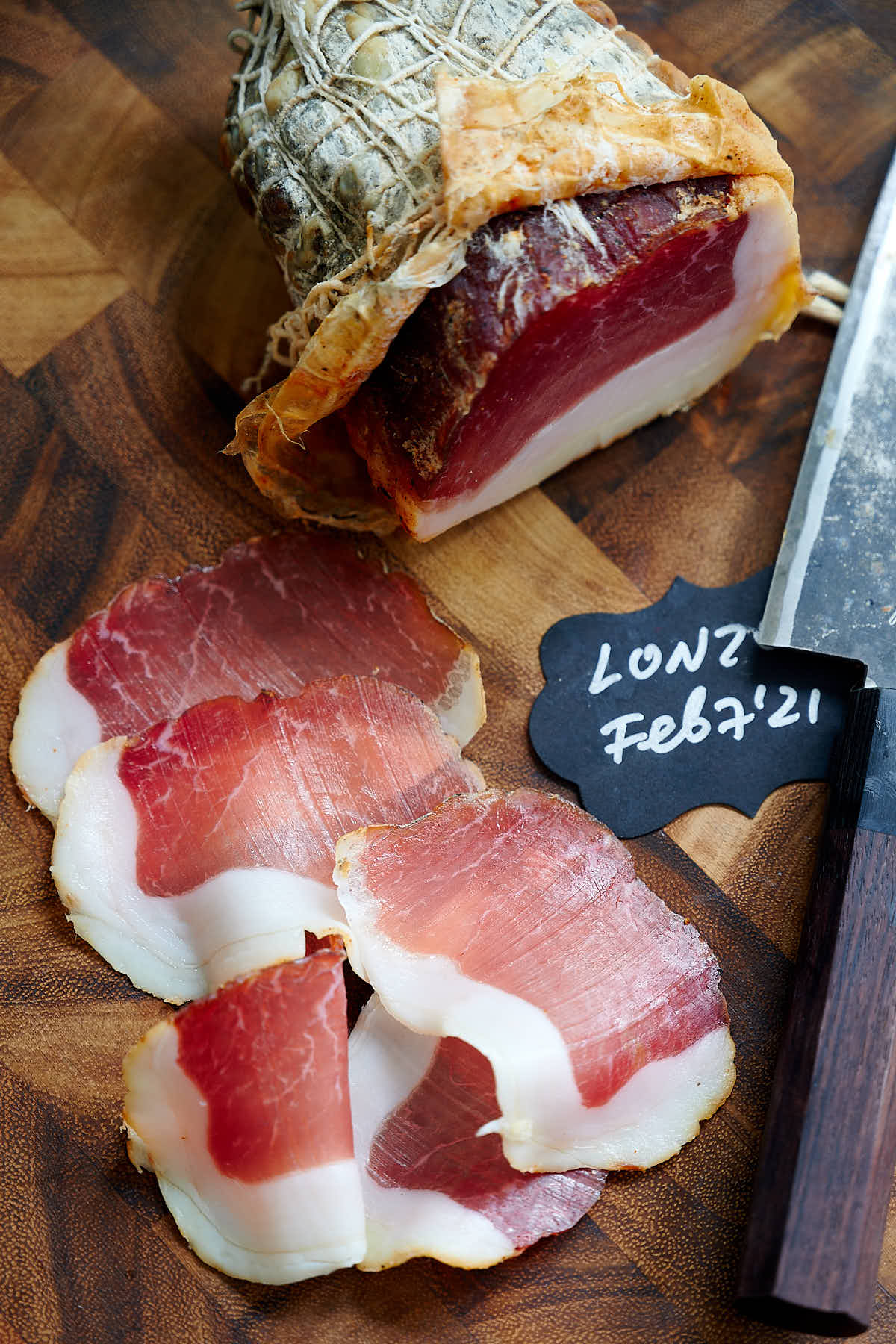
You may ask, then how do you make sure that your lonzino won't turn into jerky after 6 months? I mean, it can lose 35% of weight in just a month. The answer lies in humidity control. Forget the typically recommended 72%-75% RH. Instead, shoot for 78%-82% RH range. This will allow for a more gradual weight loss and the meat won't lose too much weight by the end of the maturation process.
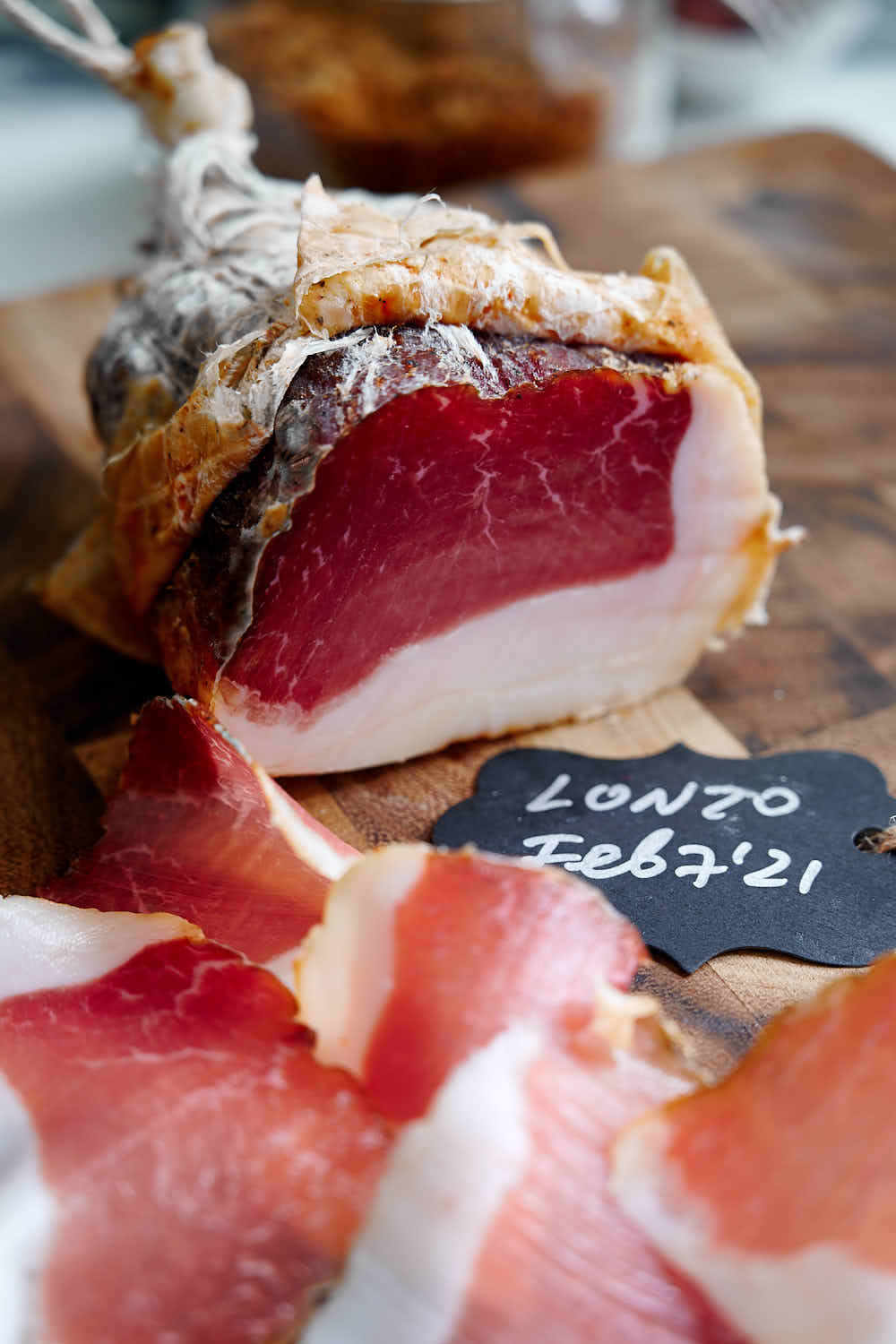
Drying needs to be clarified a little. Lately, most of my meat curing starts with fermentation and drying, after which it undergoes maturation. This process, learned from Italian butchers, was a revelation. The drying phase does not mean that the meat will become fully dry at the end of it. It only means that meat undergoes a special drying cycle to accommodate the ample initial water release. Any meat will lose water during the first 10 days or so at the highest rate. This water needs to be removed quickly and effectively otherwise the surface of the meat becomes wet, moldy, and sticky. This leads to off-flavors, the smell of ammonia, uneven drying, eventual case hardening. Sounds familiar? I've lost numerous batches to this and I had no clue as to why. Now I know.
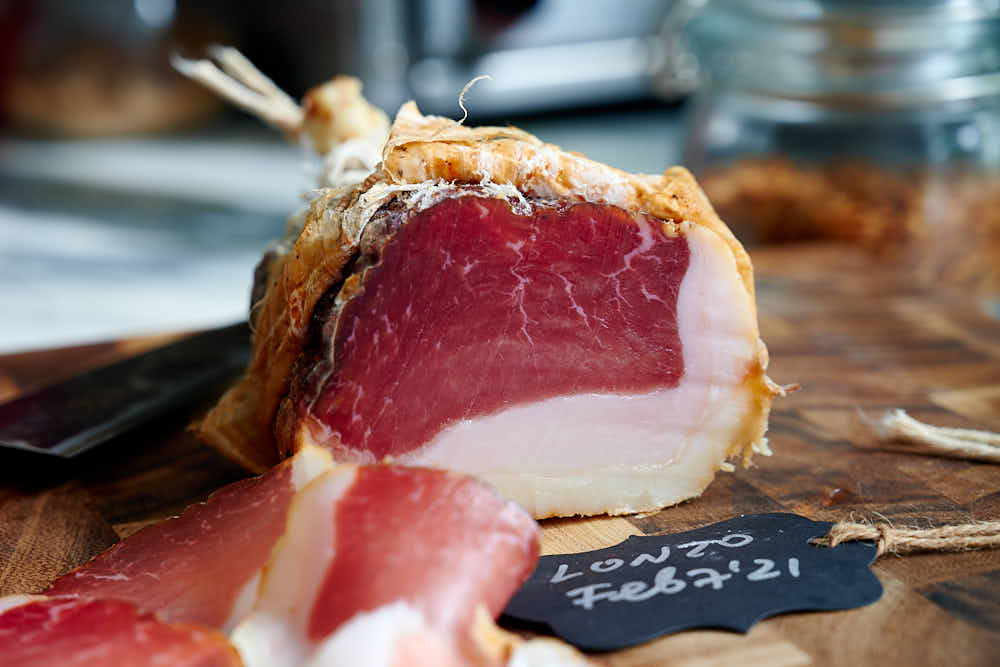
This lonzino spent 4.5 months in the curing chamber and lost 43% of its green weight. This is the longest I've matured a lonzino and it's superb. Gorgeous saturated dark red color. When my family members come and ask for more, than for a few more slices, I know it's really good. I left a fair amount of back fat on the meat and it was a welcome addition. Cured meat tastes way better when complemented by that delicious white goodness that practically melts in your mouth. The longer the fat matures the more tender and more flavorful it becomes.
The seasonings I used were very basic - salt, black and cayenne peppers, garlic powder - but the resulting flavor was outstanding. Lots of porky flavor with a hint of black pepper, a touch of garlic, and a slight bite from cayenne. This was one of my most successful charcuterie batches and I can't wait to make more lonzino.
Note that there are many ways to make lonzino and there isn't one 'right' way. After curing the meat, some butchers in Italy like to wash the meat with wine or vinegar and re-apply pepper. I prefer to scrape the surface of the meat with the back of a knife instead of washing it. The spices that you would use may also vary upon your taste. I like cayenne and garlic powder so I add them too.
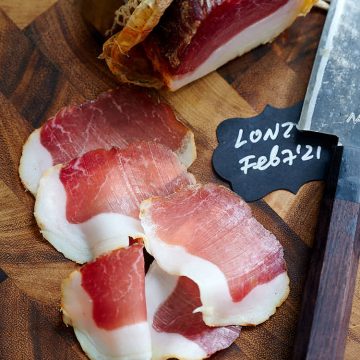
Lonzino (Cured Pork Loin)
Ingredients
- 1000 g Pork loin with back fat
- 27.5 g Salt 2.75%; coarse grain sea or kosher
- 2.5 g Cure #2 0.25%
- 1.5 g garlic powder 0.15%; 1/2 tsp
- 1 g black pepper 0.1% 1/2 tsp
- 0.5 g cayenne pepper 0.05%; 1/4 tsp
Instructions
- Trim the meat into a uniform shape.
- Weigh the meat in grams. Calculate how much of each ingredient you will need. If the pork loin wighs 1,650 grams, you will need 27.5 x 1.65 = 45.4 grams of salt, etc.
- Mix the salt, the Cure #2, the garlic poweder and the black pepper together and apply evenly to the meat. Place the meat and all the extra salt and pepper in a Ziploc bag and expel as much air as possible. Better yet, vacuum seal.
- Refrigerate for 14 days flipping the bag daily or so.
- After 2 weeks in the fridge, remove the meat from the bag, scrape the surface with the dull side of a knife. Some of the seasonings will remain, that's OK. Pat dry with paper towels if needed. Cut off any stray pieces of meat.
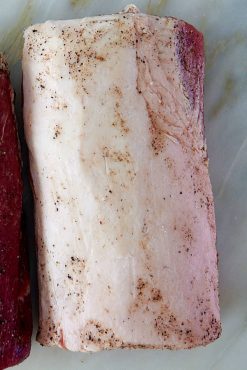
- Evenly sprinkle cayenne pepper and pat down.
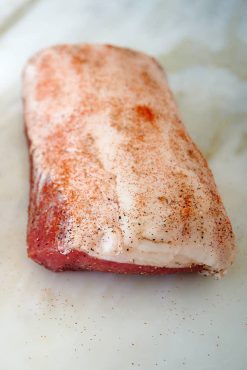
- Insert the meat into a beef bung or a similar natural casing, tie on both ends, prickle small holes all over with a sterilized needle, and truss with butchers twine. You can use stretchable netting too. Inoculate with mold if desired.
- Weigh the meat and write it down on a tag. Add the date. Attach the tag to the meat.
- Hang and dry in the curing chamber for about 7 days as per the schedule below in the note section.
- Mature in the curing chamber at 55F - 57F (13C - 14C) and 78% - 82% for 4-5 months.
- When the meat is ready, remove the casing, slice paper-thin and enjoy.
Notes
| Stage | Duration | Temp | RH |
|---|---|---|---|
| Fermentation | 10 hours | 75F (24C) | < 99 % |
| Drying | 15 hours | 72F (22C) | 75-85 % |
| Drying | 24 hours | 66F (19C) | 68-78 % |
| Drying | 24 hours | 64F (18C) | 65-75 % |
| Drying | 24 hours | 62F (17C) | 68-78 % |
| Drying | 24 hours | 60F (16C) | 72-82 % |
| Drying | 24 hours | 59F (15C) | 75-85 % |
Nutrition


Rob says
Great recipe always have done it this way.
#9 I m not sure about ? why you do that I always went straight to the curing chamber and never had any issues with my lonzino . Yes absolutely agree with your curing time the longer the better of course there is a limit to it and after that the meat could become to hard. Curing takes time! Rob
Victor @ Taste of Artisan says
Rob, as you know, meat loses the most water in the first week. This step is just a more efficient way to help remove the water from the surface of the meat, which reduces the risk mold and bacteria taking hold on the surface. Is it necessary? No. You can get away without it. I don't think I've had issues with lonzino necessarily but I have with other cured products where I had bad molds forming, slimy surface, etc. Not had that with this method. This method is used in commercial curing chambers like Stagionello and for a good reason. It helps get consistent and predictable results, IMHO.
William Miller says
On my second try at it… only a little of #1 left. Lovely stuff, though leaving it to mature is a little challenging. Not sure at my age if I will last it out.😆
Victor @ Taste of Artisan says
One of my favorite cured meats. Enjoy!
Olen says
If an adequate moisture barrier is used, to prevent to fast drying, and the formation of a dense crust on the outside, Lonzino can be cured in a refrigerator, losing adequate moisture in under 6 weeks. The film that is sold for dry-aging steaks works. But, surprisingly (& much cheaper), ordinary "rice paper" (normally used for spring rolls) works well, as long as it is pressed tightly to the meat while the rice paper is wet & pliable. Of course, the initial fermentation time & 10-14 cure time in the bag is not to be omitted..
Victor @ Taste of Artisan says
This I would argue with you on:) Fridge temps are too low for optimal flavor development. Yes, you can dry meat in the fridge, but you can't properly mature it and have good flavor development.
Norbi says
I've made it 6 months ago with hungarian mangalitza pork... I sliced it today... Maaan this is crazy delicious! Thank you for the guideline!
Victor @ Taste of Artisan says
You are welcome. Enjoy!
Andre Madern says
Hi mate,
Quick question about the scraping vs washing. I was under the impression you need to rinse/wash cured muscles to remove remaining bits of cure #2, as it could be dangerous? Can you elaborate on that a little? Please correct me if I'm wrong
Victor @ Taste of Artisan says
Hi Andre, IMHO, if you cure meat in salt boxes, a lot of that salt will remain crystallized and will need to be washed off. If you measured out the exact amount of salt/curing salt as I do in this recipe and my other recipes, all of that salt will dissolve in the water extracted from the meat. Once you drain off any accumulated liquid and pat dry the meat with paper towels, any excess salt/curing salt will be removed. I have never seen/felt any salt crystals left on meat using this method. Nor did I ever taste excessive salt on the surface of my lonzino or other cured solid muscles. It comes down to just the spices left on the surface of meat. I scrape off most but leave some behind. If you feel more comfortable washing, give it a wash in dry wine and reapply some seasonings if you want. I think both approaches are perfectly fine.
Andre Madern says
Thanks for the info Victor. I followed the recipe by the gram. I've also used plenty of your other recipes, such as the sweet Italian sausages (btw, that is an absolute banger).
One more question. My loin is more of a square-ish shape. I won't be able to squeeze it in a bung. Can I leave it uncovered (like flat pancetta)? Or would collagen sheets be preffered?
Victor @ Taste of Artisan says
Hi Andre, thank you for the kind words. I always prefer to wrap solid (meat) muscles if I can, it's just easier to control the drying process and the meat won't harden as much close to the surface. Pancetta is a bit different, it won't dry out much as it's mostly fat with some meat that's well protected by fat... I mature it at lower humidity and there is usually no mold forming on it. Lonzino is lean meat, mostly. The surface will dry out quickly if the humidity is too low. Higher humidity will bring mold, which you will have to later peel off or wash off. The drying will be uneven, it's hard to control it with such a thin piece of lean meat.
Collagen sheets will work. You can even cut a beef bung and use it as you would collagen sheets. Or use salted veil; I don't know if you have it sold where you live, but I have two stores that sell it, I just have to ask as they don't put it on display.
Olen says
IMHO, the panic about curing salt is completely unwarrented, with one exception & that is that cure#2 should not be used on meats cured for only a short time, which will be cooked at high temps...such as bacon.
Those who are in a panic do not realize that our own bodies produce nitrites daily in a quantity equal to the amount in a serving of Lonzino. Plus, most of the nitrite in the cure breaks down to harmless nitric oxide gas during the cure time. In fact, that is why cure#2 is used for long cures...to maintain the presence of the cure longer: During the cure time, while the nitrite is breaking down, the nitrate breaks down to nitrite, which then also breaks down.
Also, those panicking about nitrites should note that celery & spinach also have more nitrite per serving than the amount in this recipe BEFORE the curing time. It's all just another bogus rumor that cured meats are dangerous. What is something to consider is the amount of saturated fat they may contain. But, except for the exterior fat, pork loins are lean. So people need to worry about other actually dangerous food products!
Victor @ Taste of Artisan says
Excellent points, Olen. Hard to argue with those.
George Lathrop says
I plan to dry cure a couple of small pork tenderloins. I have read Kent and ruhlman on the subject but would also like your input. Your Pork loin recipe has the back fat on. is there a way of larding a tenderloin for curing.?
Victor @ Taste of Artisan says
Fat adds flavor. I also find cured whole muscles with some fat on them taste better with better chew/texture. They also tend to dry a little longer and hence develop more complex flavors. I butcher my own meat for curing so I have the ability to control how much backfat to leave. That said, if you are buying a loin to cure you don't have much of an option... but I wouldn't stress out about it as the difference is not huge enough to worry about it. If you want perfection, that's a different story. As far as 'larding' it, I'd get a piece of back fat to match the loin's length, tie them together tightly, case and ferment/dry/mature... just remember to remove the twine before slicing. This woldn't be dissimilar to the making of pancetta or culatello. Once they dry, the pieces will be fused together.
George Lathrop says
Thanks Victor, that is helpful. add some fat as in larding and proceed like it was a whole loin rather than a tenderloin?? Ruhlman does describe filleto which is the Tenderloin. I like your notion of graduated drying which makes sense to me. I do something similar with graduated smoking which comes out a bit better to my taste especially with fish.
Victor @ Taste of Artisan says
Oh, sorry about that George, read your first post too fast and missed the fact that you asked about tenderloins not loins. Larding can mean different things, like injecting fat into meat as one example, but yeah... I would cure the tenderloins individually for 3 days as they are small, same salt level as for the loin (2.8%)... same applies to the back fat strip... you could use a piece of bacon too... that's one of my favorite ways to cure tenderloins - cure a tenderloin and a piece of bacon of similar size, then stuff both into a beef bung with some salami mix. I will post my recipe in the near future. Then tie them together, case and net... netting would be better in this scenario but you could truss with twine over the casing. Would definitely case them... Ruhlman's recipe says tie and dry, no casing... that mold that will inhabit the surface will impart earthy/moldy flavor, I don't like it and I don't want to waste meat by peeling the top layer off. Totally, graduated drying has been very effective for me, I've seen very good results with it and barely any problems. Good luck!
Jess says
Ok, I’ve ordered some Umai bags so hopefully they will save my situation and I’ll have an update on how they work…in 5 months or so 😊.
Thanks for the explanation on cured but not dried. That makes it make a lot more sense.
I’ll definitely be doing more reading and learning so when I’m able to get set up again I am ready!
Cheers,
Jess
Victor @ Taste of Artisan says
Good luck. I think they may be ready in less than 5 months though.
Jess says
Hey Victor:
I’ve got almost to 35% weight loss in my UMai dry bag and I’ve got a bit of white mould that has formed on the surface. It looks pretty harmless but I don’t know much about what moulds are ok and what ones are bad. Can I just wash it off when the meat is done? It’s under the Umai dry bag right on the surface of my Lonzino. Is there a good solution to wash it off with?
Thanks again for all the help!
Jess
Victor @ Taste of Artisan says
Congratulations, Jess. White mold is nothing to worry about, it's harmless. It looks something like this:
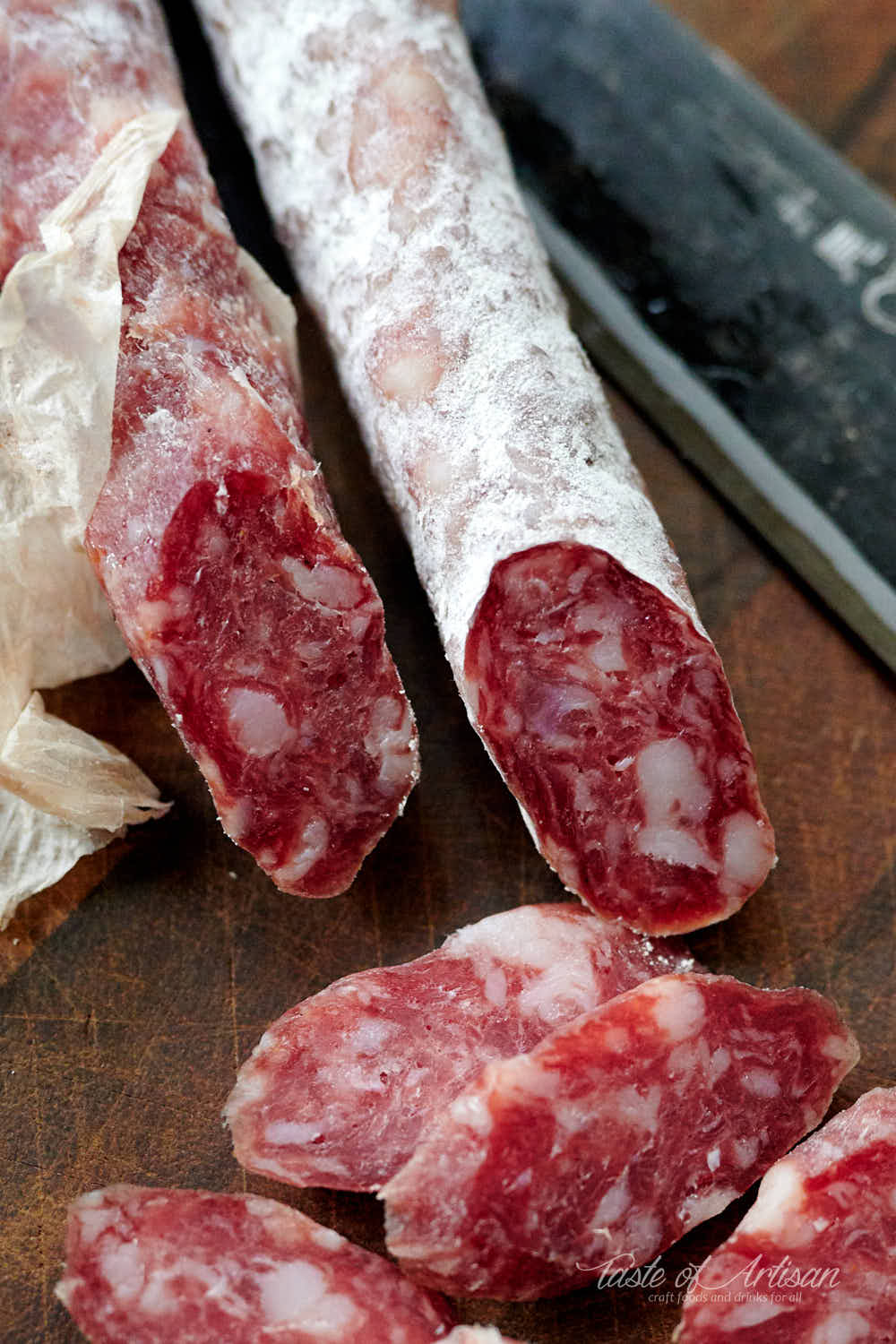
You can wash it off with clean, warm water or dry wine, whichever you prefer. Enjoy!
Jess says
Hello again Victor! Long time no write! My lonzino is done!!! (at its proper weight to be 35% moisture) It has developed some white mould as you addressed which I was rinsing, and it has a little blue in it which I am wondering about. I have not tried it yet, because I wanted to know about the mould first. It seems to be an even density all the way through, so I suspect it hasn’t case hardened. Much better than I had hoped for from the Umai dry! It took a while…started 11-21-21…so hopefully it is worth it! I also live in a more permanent location now so hopefully I can set up a proper drying chamber! Anyways, thanks for your help along the way, it’s been a game-changer to have the advice!
Jess
I will post a photo if I can figure out how, I’m not super tech-savvy. 🙂
Jess says
Hello again Victor! Long time no write.
My lonzino is officially at 35% weight lost!!! 🥳🥳🥳 It has been 15 months almost exactly. The Umai dry bag did a good job as far as I can tell, other than prolonging the process significantly. I was expecting some case hardening, but the lonzino seems to be relatively the same texture throughout. It did grow some more white mould, with a slight green in the middle. I haven’t tasted it yet as I wanted ask about that mould first. I figured I would wash it off with dry wine as suggested? I tried to post pictures but I can’t figure out how, (not very tech savvy) but if I can I will send some. So far I am very happy with it and excited to make a drying chamber for future projects as I have now moved to a more permanent location! Any suggestions for my next projects?
Thanks again for all the advice, it has been a game-changer and really helpful in encouraging me to continue!
Jess
Victor @ Taste of Artisan says
Awesome! Glad I could help. Unfortunately, readers can't post pictures, only I can do, but you can email me, and I will do it for you.
Next project? Definitely try capicola, sujuk, culatello, and various salami. So many delicious things to try.
Jess says
Hello again Victor,
I’m in the middle of curing this lonzino, just about to put it in the drying chamber, and I find I have to move 🙁. Not this month, but in the timeframe of when it will be drying. So, a few questions because of this change. Can I eat it as-is? Cured but not dried? I would have to cook it, since it’s in the same family as bacon right? Another option, have you used Umai Dry bags before for dry curing meats in a normal fridge? I won’t be able to take my dry curing setup (won’t fit in my new place) but I’ll have a fridge… Anyways, just some questions for the expert. Thanks again!
Victor @ Taste of Artisan says
Oh, no. What a disappointment. Yes, Umai bags to the rescue. I haven't used them myself but several friends of mine have and swear by them. They constantly nudge me to try so I will be trying it this month or the coming January. I already have about 20 Umai bags of various sizes for that purpose.
Now, your other ideas are not good. Cured but not dried - not good for eating. What happens during drying is that water activity of the meat drops to a certain level where potential pathogenic bacteria, due to lack of water, 'deactivate', and become harmless if ingested. I have a study on that somewhere, need to find it and link in all of my posts because this question in some form or another keeps coming up. So, you don't want to risk getting sick.
Cooking sounds like a good idea but USDA banned the usage of nitrate (cure #2) in bacon on account of carcinogens that develop during exposure to high heat. So, cooking this meat would be no good for your health. Go with Umai bags. And let me know how it turns out and take some pics. I will post mine too. Good luck!
Jess says
Woah, awesome! Love it when someone else gets to go through the learning process and I can just reap the benefits! 🙂
But seriously, thanks for this. Very good advice and super informative. You've obviously done this for a while. I'll take it small steps at a time and I'm sure there will be a lot of trial and error too. Hopefully in 5 months or so I'll have a some beautiful Lonzino pics to share! If not, there will be some learning and I'll try again. 🙂
Looking forward to the journey!
Victor @ Taste of Artisan says
Good luck! Looking forward to those pictures.
Jess says
Hey Victor,
Thanks for taking the time to write back, and for such an informative reply. This definitely answers my questions. I have also been wondering about safety so these books are a good tip for what to look into next as a I learn more. So far I've been just following recipes precisely, but I'd rather have a full understanding so I can trouble-shoot as well as discern when/why something isn't safe or didn't get a good flavor.
Thanks again! Off to do some reading.
Victor @ Taste of Artisan says
Hey Jess, let me know if you have any questions, I will be happy to help out. In general, meat curing is relatively easy. Start with a good piece of meat that is as fresh as possible. Before, I'd go to my favorite grocery store on Thursdays as that's when they get deliveries and ask for a specific cut or cuts. It's as fresh as it gets for store-bought pork, it's not even vacuum sealed at that point. When I'd get home I'd carefully trim it on all sides to remove any parts that may have touched something. It's not absolutely necessary but it makes me feel good/safe. I'd use all the cut-offs to make sausage, etc. Nowadays, I mostly get my meat for curing from a farm nearby that I've found a couple of years ago. They raise free-range heritage pigs. I love that meat. But that's not to say that you can't make excellent cured meats from regular pork.
Sanitize everything with a bleach solution following the instruction on the bottle, e.g. mines says to use 1/3 cup per gallon of water - your cutting board, knives, bowls, etc. Then rinse with water.
Keep the meat cold at all times. Process in a cold/cool room, if possible, or do it quickly.
In general, solid pieces of meat of smaller caliber (such as lonzino) are relatively easy to make, easier than salami or larger pieces such as culatello or prosciutto.
Now, the hardest part in making lonzino is drying it properly. 99% of recipes that you will find in American literature repeat the same instruction - cure, put in a casing, truss and dry at 55F and 75% RH, or something like that. What I've realized is that meat/salami releases so much water during the first week of drying that if you don
t deal with it correctly you will often have disastrous results: wet, slimy surface, smell of ammonia that permeates meat, nasty molds, case hardening, etc.
When meat releases too much water you need to remove it all somehow. It's usually done by providing sufficient airflow and/or lower humidity. In the end, what we need to achieve is to have the rate of diffusion (water coming up to the surface) equal the rate of evaporation (water leaving the surface). If water is not removed efficiently, it will cause the problems I mentioned above. Using a fan in the curing fridge (a relatively small space) often causes case hardening so it's not a good way to deal with that. Instead, and that's what modern commercial meat curing fridges of Italian origin do, we need to manipulate temperature and humidity to stimulate proper water removal from the surface of the meat. Airflow is also necessary but I find that the fan on my dehumidifier is plenty enough but not sufficient on its own, while adding an additional fan quickly causes case hardening in my fridge.
Instead, you should dry the meat using the schedule that I provided in the post or something similar. Once rapid water release has slowed down, you can then switch to a steady temp/humidity protocol to finish drying and maturing the meat. My results have improved dramatically once I've begun using this approach.
Whoa, I wrote a novel here... 😉 Hope this helps.
Jess says
Hello!
I'm about to start my Lonzino and I was wondering what percentage of weight loss I'm looking for in a finished product? I have a relatively small piece of loin, will it cure faster? Can I "check" it for doneness during the aging process?
Thanks so much! Just getting into aging but very excited.
Victor @ Taste of Artisan says
About 30% to 35%. Smaller pieces will cure faster but there will be no harm if you cure the meat for a little longer.
There is no simple way to check for 'doneness'. To me, the primary 'doneness' factor is meat safety. It's done when it's safe to eat. The meat needs to be dry enough, or have a low enough water activity level, to ensure that there are no pathogenic bacteria in it which will make you sick. I read a study once which found that most pathogenic bacteria, if present in meat, will deactivate after 28 days of drying so every single piece of meat that I make is left in the curing chamber for no less than 4 weeks. Another thing to consider is how the meat is drying. If you squeeze it and it feels hard on the outside and soft and squishy on the inside, you have case hardening. This means that you may have the right overall weight loss but inside, water activity will be high enough to harbor active pathogenic bacteria. So, in general, I consider something as 'done' if it's been drying for 4 weeks at least, evenly firm (inside and outside) and has lost a sufficient amount of weight (30-35% for lonzino). This is a very crude guideline because there are other factors to consider if you want to produce a better piece of meat, better flavor.
If you are just starting out, I strongly suggest reading Marianski's books on dry curing to get your safety down. You can start here too - https://www.meatsandsausages.com/sausage-making/meat-safety.
Alvar says
Congratulations, Victor.
Great, as always.
Lonzino was among the first salumi I decided to try, since it seemed to me something not so commonly made, somehow almost forgotten or left aside for other , 'better' products.
DOP states that through the centuries, the lonzino was gradually displaced by other, fattier, salumi, since in ancient times more fat was a standard for more quality.
However, I was right on my hunch, since turned to be a superb salumi, very delicate and balanced, provided enough patient caring and maturing is given to them.
As you, it did not seem quite right to me, when I read that had to be spiced aggresively, etc. (Maybe Ruhlman's?).
Later on (after making something like 25-30 pieces), I've got the Delle Marche DOP info, -which comes very close to your recipe-, and I slight adjusted mine, getting consistently an excellent product, which even can achieve, when propery done, the almost-jambon-like nutty and earthy taste behind it all.
Also I noticed that once the lonzino is cut, on subsequent days the flavour and taste developes somehow into a more complex and delicious experience.
Thanks once more for sharing this.
I would like to share few pics of my lonzinos.
Victor @ Taste of Artisan says
Hey Alvaro, awesome pictures, I am sure it tastes just as good. Fat definitely adds more flavor, not surprised that it's more popular with people that way. When I butcher a pig I leave a good amount of back fat attached to the loin, similar to what you have on pictures 1 and 2 above, it makes a better lonzino especially if you let it age long enough.
Aggressive seasoning may have been the result of the poor quality of pork. Commodity pork lacks in flavor so it's a natural instinct to compensate it by seasonings. The good news is that more and more farms pop up everywhere here that grow heritage pork of high quality at reasonable prices. Regardless, even when using commodity I pork I tend to go lower on seasonings and still get a very nice piece of salumi.
You are making an interesting observation about the flavor developing after cutting. I've noticed that too but wasn't sure whether it was my imagination or that was in fact true. If that happens it's likely because of oxidation which is usually thought of as a negative. Interesting.
Jerrold Cavasin says
I enjoy your recipe's and have made many of them even though I am not an apprentice at this. We (wife and son's) have been doing this for many years and our family going back up to 500 years in Italy.
Your recipe's are a delight to some of the more basic traditional ones we have used for centuries. I might add "safer."
Anyways my question is: how long do you estimate a seasoned, salted, #2 cured by weight loin will last vac sealed in my curing fridge at 34 degrees? I have several that are 5 months old because of a hospitalization situation. The ones that are vac sealed look great and the ones that were seasoned as above and wine added then all air removed have absorbed all the wine and are firm, and smell great. Should I try to dry them? Sounds silly but I read on a site that once salted, seasoned and cured added by weight that they can last longer than we can imagine especially if sealed without air. Better conditions than just salted in a barrel on a pirate's ship. Har har har har!
What thinketh thou????
Currently we are eating vac sealed lonzini, salami, pancetta, prosciutto, bacon, pepperoni and other treats that are up to 3 yrs old 40%-50% weight loss, vac sealed and kept in my drying fridge at 55 degrees.
Thank you for your advise.
God bless and keep up the great site!
Victor @ Taste of Artisan says
Hi Jerrold, thank you very much for the compliment. Comments such as this one keep me going. I appreciate them.
To answer your question, I don't really know how long but I also tend to think that it should be quite long. Five months doesn't sound that long for a piece of meat that is properly salted and cured with proper salt ratios, and kept refrigerated at 34F. I think I've gone as long as 2-3 months before drying (got busy and forgot about them) and they turned out just fine. I too vac sealed them. Interestingly, I've never come across a warning in any of the many charcuterie books I've read to 'NOT CURE LONGER THAN...' It's usually 'Cure for at least...'. No time limit. Some of my cured bacon (also vas sealed) sits in the fridge for many months, close to a year if I make a very big batch, always looks and smells fresh. Well, not always... I once had a batch that developed some sort of slime on the surface and smelled bad... it was when I tried to make low-sodium bacon, it didn't work out well.
Three-year-old salmumi, ha? That's impressive. I bet they can keep fresh and tasty for many more years. Do you remove casings before vac sealing?
Jerrold Cavasin says
Greetings!
Thank you for the quick response.
I have bacon that we made that is vac sealed and refrigerated going on a year at the present time and taste great. But our bacon is cured for about 7 days then smoked for 5 hours and brought to an internal temp of 160 degrees. Then we get it to "sweat" down 25-30% before it's considered done. It's fully cooked so you can slice and eat if you want and sometimes "we want!" Don't forget to gather the "sweat" as it is more powerful in flavor than just bacon grease. Our Southern neighbors wait in line to get a few tablespoons when it's their turn.
We vac seal all our salami's, lonza's, ect with casings if they have them on. Sometimes we don't case the lonzini just net and dry. Many of our meats are spice coated before sealing to add a deeper flavor "over time." We just did our first country ham and it's a year old hanging in the basement wrapped in cheesecloth. Finished weight is 16 lbs after a 21.5 lb green start.
Anyways our smoker looks a lot like yours as it is made with tongue and groove 5.5" x .75" cedar milled off a friends property about 50yrs ago. When I get this laptop fixed and can transfer some pics to it I will post some pics of our homemade smoker, drier, and curing box. Lots of designing and "making" them work.
Hey anyways great to find you on your site.
Well if I can get an address from you I could send you some product when it's ready. Right now we are in "hold" mode due to some ill health of my wife but we shall rise soon enough "Lord willing." Anyways we have 80+ lbs of ground pork waiting to be "put to work" and fresh sausage is all we have time and ability to make.
So have a blessed day. Thanks for the help. Next week I'll start drying those cured loins that should be fantastic for flavor.
God's blessings.
Jerry
The Sultan of Salami
Victor @ Taste of Artisan says
Thanks for the detailed response, Jerrold. Always love to hear about other methods and I picked up a couple of interesting tips from your response that I would like to adopt. I will send you an email.
All the best to you and your family!
Victor